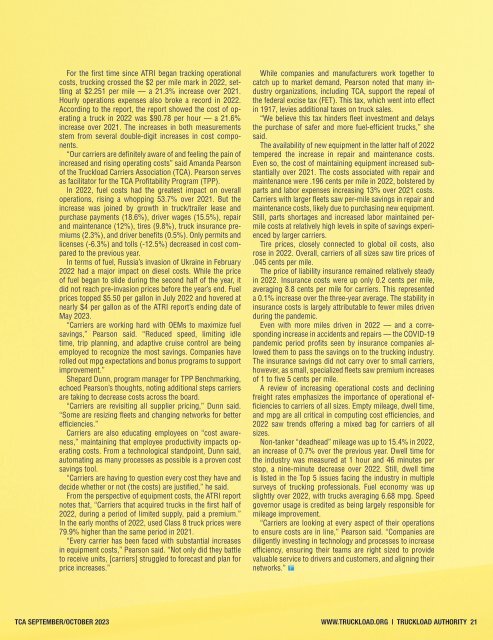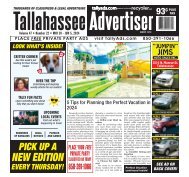TLA62_AllPages
You also want an ePaper? Increase the reach of your titles
YUMPU automatically turns print PDFs into web optimized ePapers that Google loves.
For the first time since ATRI began tracking operational<br />
costs, trucking crossed the $2 per mile mark in 2022, settling<br />
at $2.251 per mile — a 21.3% increase over 2021.<br />
Hourly operations expenses also broke a record in 2022.<br />
According to the report, the report showed the cost of operating<br />
a truck in 2022 was $90.78 per hour — a 21.6%<br />
increase over 2021. The increases in both measurements<br />
stem from several double-digit increases in cost components.<br />
“Our carriers are definitely aware of and feeling the pain of<br />
increased and rising operating costs” said Amanda Pearson<br />
of the Truckload Carriers Association (TCA). Pearson serves<br />
as facilitator for the TCA Profitability Program (TPP).<br />
In 2022, fuel costs had the greatest impact on overall<br />
operations, rising a whopping 53.7% over 2021. But the<br />
increase was joined by growth in truck/trailer lease and<br />
purchase payments (18.6%), driver wages (15.5%), repair<br />
and maintenance (12%), tires (9.8%), truck insurance premiums<br />
(2.3%), and driver benefits (0.5%). Only permits and<br />
licenses (-6.3%) and tolls (-12.5%) decreased in cost compared<br />
to the previous year.<br />
In terms of fuel, Russia’s invasion of Ukraine in February<br />
2022 had a major impact on diesel costs. While the price<br />
of fuel began to slide during the second half of the year, it<br />
did not reach pre-invasion prices before the year’s end. Fuel<br />
prices topped $5.50 per gallon in July 2022 and hovered at<br />
nearly $4 per gallon as of the ATRI report’s ending date of<br />
May 2023.<br />
“Carriers are working hard with OEMs to maximize fuel<br />
savings,” Pearson said. “Reduced speed, limiting idle<br />
time, trip planning, and adaptive cruise control are being<br />
employed to recognize the most savings. Companies have<br />
rolled out mpg expectations and bonus programs to support<br />
improvement.”<br />
Shepard Dunn, program manager for TPP Benchmarking,<br />
echoed Pearson’s thoughts, noting additional steps carriers<br />
are taking to decrease costs across the board.<br />
“Carriers are revisiting all supplier pricing,” Dunn said.<br />
“Some are resizing fleets and changing networks for better<br />
efficiencies.”<br />
Carriers are also educating employees on “cost awareness,”<br />
maintaining that employee productivity impacts operating<br />
costs. From a technological standpoint, Dunn said,<br />
automating as many processes as possible is a proven cost<br />
savings tool.<br />
“Carriers are having to question every cost they have and<br />
decide whether or not (the costs) are justified,” he said.<br />
From the perspective of equipment costs, the ATRI report<br />
notes that, “Carriers that acquired trucks in the first half of<br />
2022, during a period of limited supply, paid a premium.”<br />
In the early months of 2022, used Class 8 truck prices were<br />
79.9% higher than the same period in 2021.<br />
“Every carrier has been faced with substantial increases<br />
in equipment costs,” Pearson said. “Not only did they battle<br />
to receive units, [carriers] struggled to forecast and plan for<br />
price increases.”<br />
While companies and manufacturers work together to<br />
catch up to market demand, Pearson noted that many industry<br />
organizations, including TCA, support the repeal of<br />
the federal excise tax (FET). This tax, which went into effect<br />
in 1917, levies additional taxes on truck sales.<br />
“We believe this tax hinders fleet investment and delays<br />
the purchase of safer and more fuel-efficient trucks,” she<br />
said.<br />
The availability of new equipment in the latter half of 2022<br />
tempered the increase in repair and maintenance costs.<br />
Even so, the cost of maintaining equipment increased substantially<br />
over 2021. The costs associated with repair and<br />
maintenance were .196 cents per mile in 2022, bolstered by<br />
parts and labor expenses increasing 13% over 2021 costs.<br />
Carriers with larger fleets saw per-mile savings in repair and<br />
maintenance costs, likely due to purchasing new equipment.<br />
Still, parts shortages and increased labor maintained permile<br />
costs at relatively high levels in spite of savings experienced<br />
by larger carriers.<br />
Tire prices, closely connected to global oil costs, also<br />
rose in 2022. Overall, carriers of all sizes saw tire prices of<br />
.045 cents per mile.<br />
The price of liability insurance remained relatively steady<br />
in 2022. Insurance costs were up only 0.2 cents per mile,<br />
averaging 8.8 cents per mile for carriers. This represented<br />
a 0.1% increase over the three-year average. The stability in<br />
insurance costs is largely attributable to fewer miles driven<br />
during the pandemic.<br />
Even with more miles driven in 2022 — and a corresponding<br />
increase in accidents and repairs — the COVID-19<br />
pandemic period profits seen by insurance companies allowed<br />
them to pass the savings on to the trucking industry.<br />
The insurance savings did not carry over to small carriers,<br />
however, as small, specialized fleets saw premium increases<br />
of 1 to five 5 cents per mile.<br />
A review of increasing operational costs and declining<br />
freight rates emphasizes the importance of operational efficiencies<br />
to carriers of all sizes. Empty mileage, dwell time,<br />
and mpg are all critical in computing cost efficiencies, and<br />
2022 saw trends offering a mixed bag for carriers of all<br />
sizes.<br />
Non-tanker “deadhead” mileage was up to 15.4% in 2022,<br />
an increase of 0.7% over the previous year. Dwell time for<br />
the industry was measured at 1 hour and 46 minutes per<br />
stop, a nine-minute decrease over 2022. Still, dwell time<br />
is listed in the Top 5 issues facing the industry in multiple<br />
surveys of trucking professionals. Fuel economy was up<br />
slightly over 2022, with trucks averaging 6.68 mpg. Speed<br />
governor usage is credited as being largely responsible for<br />
mileage improvement.<br />
“Carriers are looking at every aspect of their operations<br />
to ensure costs are in line,” Pearson said. “Companies are<br />
diligently investing in technology and processes to increase<br />
efficiency, ensuring their teams are right sized to provide<br />
valuable service to drivers and customers, and aligning their<br />
networks.”<br />
TCA SEPTEMBER/OCTOBER 2023 www.Truckload.org | Truckload Authority 21

















